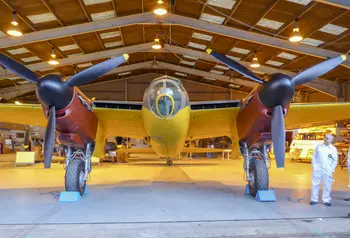World’s first operational radar station to be restored

Set to be transformed are the Bawdsey Radar Transmitter Block in Suffolk, home to the world’s first operational radar station, and the de Havilland Aircraft Museum in Hertfordshire, the oldest aviation museum in the UK. These projects will explore events which changed the lives of an entire nation, and had an impact felt across the world.
Robyn Llewellyn, Head of HLF East of England, said: “The East of England played a vital role during the Second World War, particularly in the field of aviation.
"Thanks to National Lottery players, HLF has been able to invest in two transformational projects that will ensure many more people in the region and beyond are able to explore these pivotal stories from one of the most important periods in our nation’s history.”
Birthplace of radar
The Bawdsey Radar Trust has received just over £1.4m from HLF to help deliver a £1.8m project that will conserve the Transmitter Block building on Bawdsey Manor Estate in Suffolk. The project will increase opportunities for the public to learn about this pioneering radar site.
Radar helped the Allies win the Second World War, playing a vital part in the Battle of Britain in 1940. It is estimated the technology helped shorten the war by two years. Built in 1938, the Transmitter Block at RAF Bawdsey was the site of the world’s first operational radar station. Now Grade II* listed, it is currently on Historic England’s Heritage at Risk Register and in need of urgent repair.
As well as plans to conserve the fabric of the building, Bawdsey Radar Trust will be working to develop ways in which more people can visit the site and understand the importance of the radar heritage that the Transmitter Block represents. These will include new displays within the Block telling the story of radar and its huge significance to the Second World War and beyond.
An important part of the project will be providing opportunities for learning about radar’s fascinating social and scientific history. This will include the story of how the early radar work at Bawdsey laid the foundation for our current age of electronics, leading to inventions such as GPS, accurate weather forecasting, speed safety cameras and even the microwave oven.
[quote=Therese Coffey, MP for Suffolk Coastal] "It is incredibly important we tell the Bawdsey and Suffolk coast story of where radar originated and its key role in World War II."[/quote]
Therese Coffey, MP for Suffolk Coastal, said: “I’m delighted that Bawdsey Radar have been successful in obtaining £1.4m from HLF. It is incredibly important we tell the Bawdsey and Suffolk coast story of where radar originated and its key role in the Second World War.
"I congratulate all involved with the Bawdsey Radar project on their imaginative scheme to restore the transmitter block and enhance the experience for visitors. This adds to the recent funding secured from the Coastal Communities Fund, all of which contributes to our tourism as well as securing key heritage for our nation.”
The de Havilland Museum in the 21st century
The de Havilland Aircraft Museum in London Colney, Hertfordshire, has received initial support and an award of £62,200 from HLF. The grant will help the museum develop its £1.5million project to build a new hangar for its outstanding collection of de Havilland aircraft.
As a company, de Havilland was a pioneer in aviation technology. It was responsible for the:
- de Havilland Sea Vampire, the first jet aircraft to take off and land on an aircraft carrier
- de Havilland Comet, the first commercial jet airliner in the world
- de Havilland Mosquito, the fastest propeller warplane for most of the Second World War
The Museum’s new hangar will be linked to the main hangar, which was built in the early 1980s and houses the DH98 Mosquito prototype as well as two other Mosquitos. It will replace the museum’s small original hangar in which its first aircraft, the Mosquito prototype, was initially housed.
The new building will improve conservation and provide a better space to display and tell the story of de Havilland’s aircraft, enabling better access for wider audiences, as well as providing capacity for volunteering, learning and skills development.
[quote=Mike Nevin, Marketing Director]"The new hangar is the most ambitious project on which the museum has ever embarked since it opened to the public in 1959." [/quote]
“We are delighted to receive this grant from HLF,” Mike Nevin, de Havilland Museum Marketing Director, said. “It will enable us to take the next step to achieving the principle objectives of the museum and engaging with the community.
“The new hangar is the most ambitious project on which the museum has ever embarked since it opened to the public in 1959. It will see us becoming even more closely involved with the community as we will be developing close links with local schools and organisations and providing employment and training opportunities.”
Further information
- HLF: Felix Gott, Communications Manager, on tel: 020 7591 6138.
- de Havilland Aircraft Museum: Peter Jeffery, Public Relations Manager, on tel: 0775 987 9966.
- Bawdsey Radar Trust: Miriam Stead, Project Steering Group, on tel: 07902 411760.
